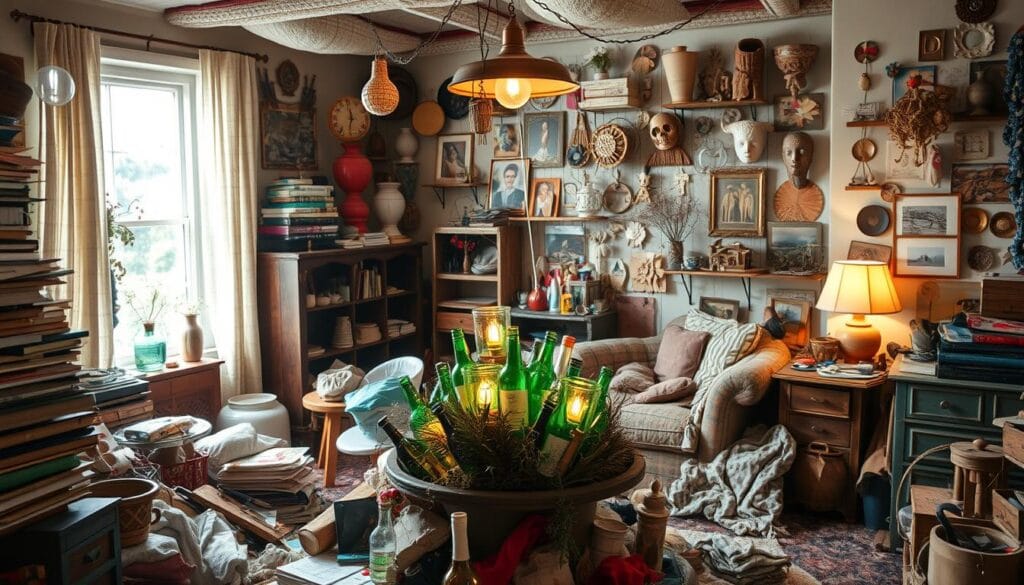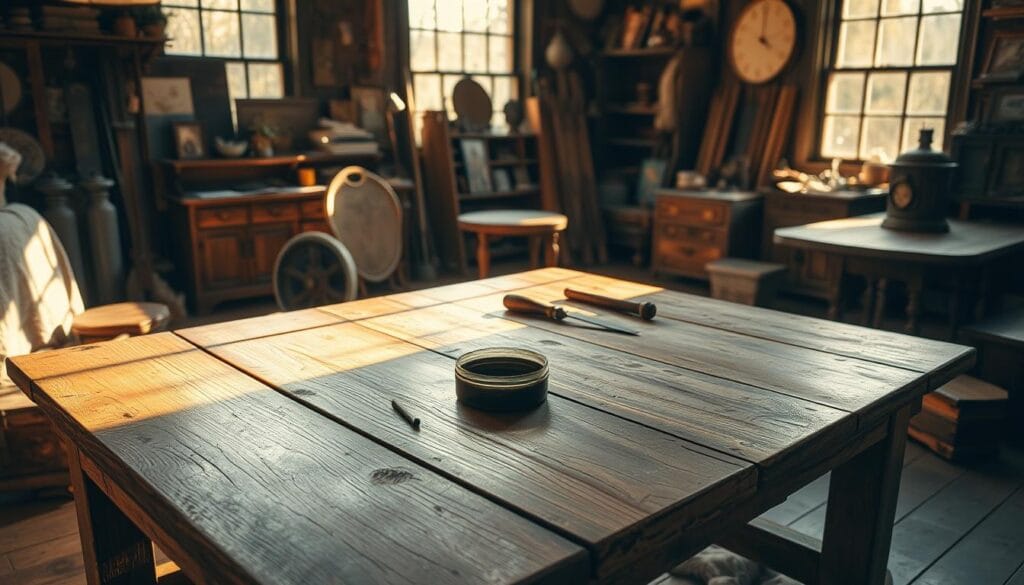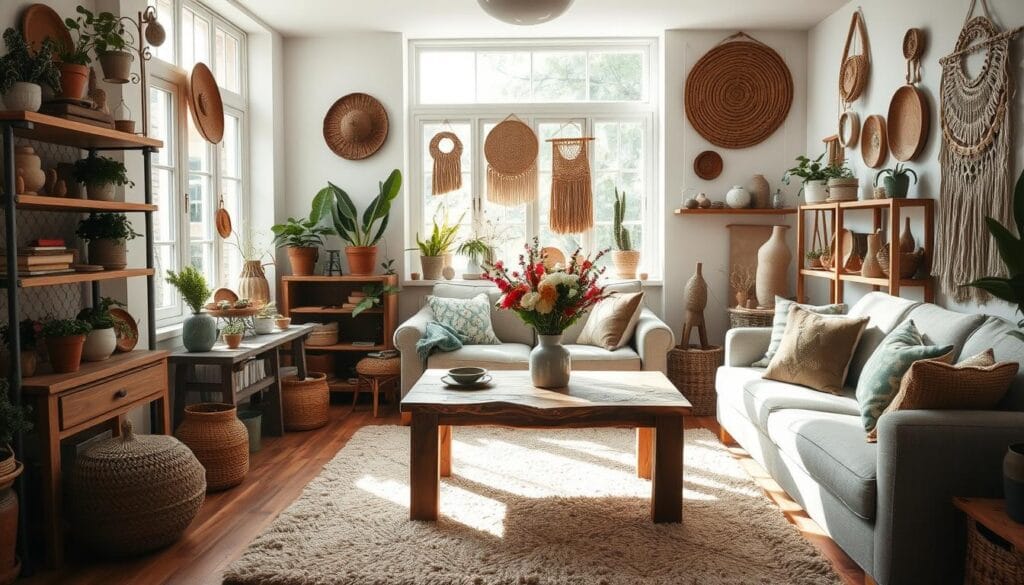Last summer, I found my grandmother’s vintage suitcase in the attic. It looked old and useless, ready for the trash. But the DIY lover in me saw a chance to create something new. With a bit of work, I turned it into a stylish coffee table. It made my living room stand out and started many conversations. This project made me love upcycling, a cheap and earth-friendly way to decorate.
Do you like making your own home decor? If so, you’ll love the endless ideas upcycling offers. Upcycling reduces waste and lets you make unique items. Plus, 73% of people are trying to be more sustainable like this. By upcycling, you can cut down on waste by 30% and save about 50% instead of buying new. It’s a smart way to give old items a new life and keep your home looking great.
Key Takeaways
- Upcycling projects can reduce waste by up to 30%.
- 73% of consumers are embracing sustainable practices, including upcycling.
- Upcycling can save an average of 50% compared to purchasing new items.
- Approximately 60% of households have items that can be upcycled.
- DIY home decor through upcycling adds personal satisfaction and improves aesthetics.
The Importance of Upcycling in Today’s World
In a world increasingly concerned with sustainability, the environmental benefits of upcycling are more vital than ever. Upcycling helps reduce landfill waste and saves resources. For example, the UK generates about 2.7 million tons of furniture waste each year. Repurposing these materials can make a big difference.
The global upcycling market is set to reach $413 billion by 2027. It’s growing fast, at a rate of 6.2% from 2020. About 70% of shoppers now prefer to buy upcycled goods. This shows how big the economic benefits of repurposing items can be.
Understanding the difference between upcycling and recycling is crucial. Recycling breaks down materials to make new ones, while upcycling upgrades waste into more valuable items. Upcycling uses less energy and resources, making it more sustainable than recycling.
Upcycling can also cut carbon emissions by up to 70% compared to making new items. This is key in efforts to reduce our carbon footprint and address climate change.
Every year, the U.S. throws away about 9.1 million tons of textiles. Choosing upcycling over throwing things away offers a sustainable choice. With each household throwing out 4.4 pounds of waste daily, upcycling has great potential. Upcycled furniture, for instance, can be sold for 20-30% more than new pieces, which shows people are willing to pay more for sustainability.
Upcycling can save around 1.5 billion gallons of water every year. It’s vital for producing new goods. It also helps local economies by creating jobs and encouraging community involvement. Some programs boost local involvement by as much as 35%.
The fashion industry contributes to about 10% of global carbon emissions. This makes sustainable alternatives like upcycling even more important. Americans discard about 81 pounds of clothing per person every year. There’s huge potential to cut down textile waste through creative repurposing.
Upcycling’s importance in today’s world is huge. By choosing to upcycle, we help our planet and encourage others to live more sustainably. The environmental benefits of upcycling are clear, making it a crucial practice for a sustainable future.
Upcycling in the Living Room: Functional and Stylish
Let’s talk about adding sustainability and creativity to our living rooms. Upcycling old furniture into new finds is a great trend. It makes our homes look fresh and helps the planet too.
One top idea is turning an old dresser into a creative coffee table. Just add a few coats of Jolie Matte paint and some epoxy remover. This project is affordable, costing about $50 to $150.
DIY fans will enjoy making shelves out of pallets. Pallets can be cheap or even free. Some sanding and paint turn them into unique, useful pieces. This adds a personal touch without much expense.
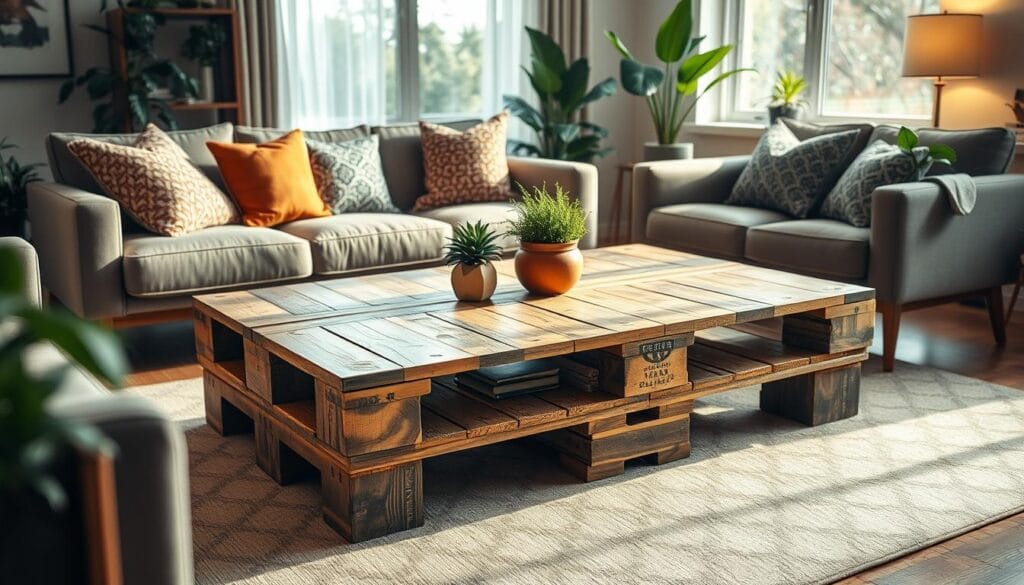
Old books can also be upcycled into a cool side table. Drill a hole, thread a dowel, and stack them up. It’s a low-cost project that becomes a conversation starter in your home.
Upcycling is more than saving money; it’s a stand for the environment. In the U.S., we throw away over 9 million tons of furniture each year. Upcycling not only fights this waste but can also increase an item’s resale value by 20%.
Here’s a summary of some upcycling projects and their benefits:
| Project | Average Cost | Benefits |
|---|---|---|
| Rope Star Mirror | Less than $25 | It brings a nautical look and is cost-effective |
| Rattan Basket (IKEA) | $30 | Offers stylish storage |
| Princess Castle (Cardboard) | Free with available materials | Encourages creative play for children |
| Peel-and-Stick Wallpaper Cabinet | Cost varies, generally under $50 | Gives old furniture a new, personalized look |
| Upcycled Shelves from Pallets | Little to no cost | Provides unique, customizable storage |
Turning a dresser into a coffee table or making shelves from pallets shows upcycling’s power. It combines functionality with style. It’s a way to find creative and sustainable solutions without leaving home.
Kitchen Upcycling: From Waste to Creative Solutions
Let’s jump into the kitchen, the heart of the home. Here, turning glass jars into storage solutions changes the ordinary into something special. Glass jars, often thrown away, become stylish spots for cereals, spices, and snacks. This clears your kitchen and brings in charm!
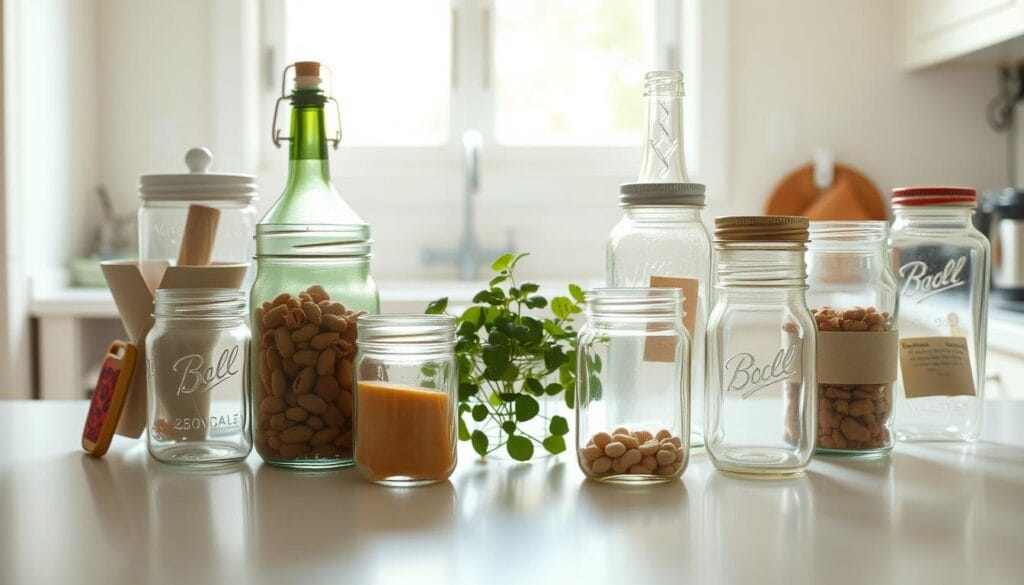
Also, we should look at using wooden crates for creative kitchen organization. These crates add a rustic look and are very useful. They can hold fresh produce or organize cookware. You can stack them for a cool open shelving system, making items easy to reach.
Don’t forget about old utensils. Upcycling them offers new ways to decorate your kitchen. Turn old forks and spoons into cute hooks for aprons and towels. Or make them into original handles for cabinets and drawers. These ideas mix usefulness with beauty, showing off sustainable living.
The plus sides of kitchen upcycling go beyond looking good. In 2023’s ‘Green Revolution,’ these actions show we care for the environment. Amazingly, research shows up to 30% of home waste can be reused in such ways, helping our planet a lot.
Also, more people see the value in being eco-friendly. Studies reveal that 70% of folks would buy upcycled items. This shows more people like and support green choices.
By doing this, you can save money—about $300 a year—and cut down on waste. With the upcycling market expected to grow 12% from 2021 to 2026, it’s the perfect time to try new things in the kitchen.
Bedroom Makeover: Chic and Sustainable Upcycling
Want to make your bedroom chic and green without spending much? Upcycling lets you beautify your space, reduce waste, and choose eco-friendly options. You can turn old doors into a headboard, freshen up nightstands, and use fabric scraps for pillows. This transforms your bedroom wonderfully.
Upcycling is more than a trend; it’s a way to live sustainably. As of 2023, the ‘Green Revolution’ is helping us live better. By choosing upcycling, you can cut costs by half on home decor and furniture. In the U.S., about 9.7 million tons of furniture are thrown away each year. Upcycled furniture is key to solving this issue.

Picture your bedroom with a unique headboard made from old doors. This adds character and a story to your room. Turning old doors into a headboard is a fun project. Just sand them, paint with eco-friendly paint, and put them behind your bed. This simple change makes a big difference.
Nightstands are a must-have, but getting the right look can be hard. Upcycled nightstands open up endless possibilities. You can have a vintage, modern, or rustic nightstand by being creative. Choosing safe paints can also make your room’s air cleaner. These paints have much lower VOC than regular ones.
And don’t toss those fabric scraps! Using them for pillows is smart. Most thrown-away textiles could actually be reused. These unique pillows add color and coziness to your room. They show off your creativity and care for the environment.
| Project | Time Required | Cost Savings | Environmental Impact |
|---|---|---|---|
| Crafting a Headboard from Old Doors | 4-6 hours | 50-70% compared to buying new | Reduces landfill waste by up to 75% |
| Upcycled Nightstands | 2-4 hours | 30-50% cheaper than new | Lowered carbon emissions by 30% |
| Using Fabric Scraps for Decorative Pillows | 1-3 hours | 70% saving on retail prices | Diverts textiles from landfills |
Making a headboard from old doors, redoing nightstands, and creating fabric scrap pillows spruce up your bedroom and help the planet. Upcycling is a green choice that shows you care about the environment. It turns your space into a stunning and meaningful retreat 🌍.
Upcycling for Outdoor Spaces: Beautifying Your Garden
Imagine stepping into a garden where creativity blooms alongside plants. Here, *reimagining old tires into garden planters* not only saves waste but also transforms your outdoor haven. Let’s explore some innovative ways to give new life to everyday objects, making your garden a shining example of sustainability.
One of our top projects is reimagining old tires into garden planters. This simple yet eye-catching idea keeps waste out of landfills and becomes a unique feature in your garden. With some paint and creativity, old tires can turn into colorful planters, adding charm to any outdoor area.
But upcycling isn’t just about tires. Here are some more great ideas for upcycled furniture and garden art that will change your backyard:
| Item | Upcycling Idea | Impact |
|---|---|---|
| Wooden Pallets | Turn into garden benches or tables | Reduces waste, creates functional outdoor furniture |
| Glass Bottles | Create colorful garden borders | Enhances garden aesthetics, repurposes glass materials |
| Old Furniture | Convert into garden storage or planter stands | Extends furniture lifespan, adds practical storage |
Eco-friendly outdoor decor can make your garden look great and support green practices. By using *reimagined old tires into garden planters* and other recycled items, you help reduce waste. Upcycling can divert 10-20% of household waste from landfills, aiding the Green Revolution.
Making garden art from recycled materials is a fun way to show your creativity. For example, using old metal or wood to make sculptures or garden ornaments beautifies your space and reduces your environmental impact. DIY enthusiasts have increased their use of upcycled materials in garden projects by 40% in the last two years. This shows a big move towards eco-friendly gardening.
It’s not all about looks; upcycled furniture and decor can also save you money. Did you know upcycling furniture can be 70% cheaper than buying new? DIY upcycling projects can also cut garden decor costs by about 25%. Since about 60% of people upcycle to show their creativity, it’s clear that sustainable outdoor projects are both fun and good for your wallet.
Lastly, *reimagining old tires into garden planters* and other upcycling efforts make your garden an example of green artistry. These projects not only improve the beauty of your garden by an estimated 15-20% but also support a zero-waste lifestyle. Embrace these ideas, and your garden will become a stunning symbol of sustainability and creativity.
Creative Upcycling Ideas for the Bathroom
Our bathroom is often small, which makes it great for DIY upcycling projects. Think about turning old towel bars into stylish places for your things. This change makes them useful and beautiful at the same time.
We love making a unique vanity by using different old items. You could use an old dresser or wooden crates. A new coat of paint or new handles can make a big difference.
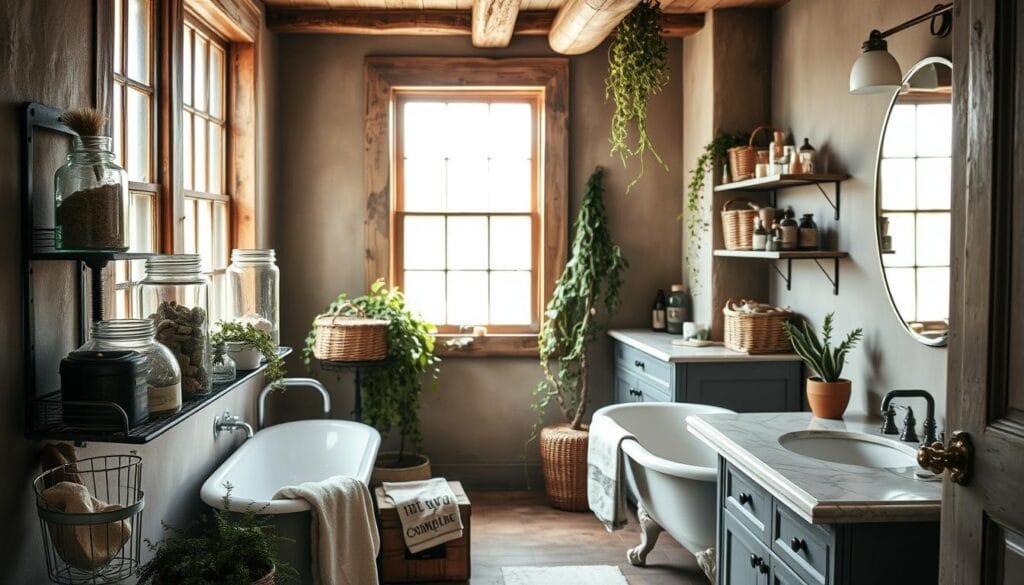
Try using glass bottles as decorations too. You can paint them, wrap them in twine, or fill them with colorful bath salts. These bottles can add a fun and classy touch to your bathroom.
Let’s look at some specific ideas:
- Turning old towel bars into stylish storage: Add baskets or shelves to these bars for more space.
- DIY upcycled vanity from found objects: Use unique items to make a special vanity.
- Transforming glass bottles into decorative accents: Decorate old bottles for a stylish look.
Upcycling in the bathroom reduces waste and personalizes your space. Here’s how these projects can change your bathroom:
| Project | Materials Needed | Cost |
|---|---|---|
| Turning Old Towel Bars into Stylish Storage | Old towel bars, baskets, shelves | $10 – $20 |
| DIY Upcycled Vanity from Found Objects | Antique dresser, wooden crates, paint | $50 – $100 |
| Transforming Glass Bottles into Decorative Accents | Old glass bottles, paint, twine | $5 – $15 |
We hope you feel inspired to be creative in your bathroom. Turning old towel bars into stylish storage and upcycling can make your space both useful and beautiful.
Upcycling for Kids’ Rooms: Fun and Functional Projects
Welcome to the exciting world of upcycling for kids’ rooms! It’s like bringing a sparkle of creativity to your child’s area and being kind to the planet. Imagine making Toy Storage from Old Suitcases. These make the room neater and add a fun touch.
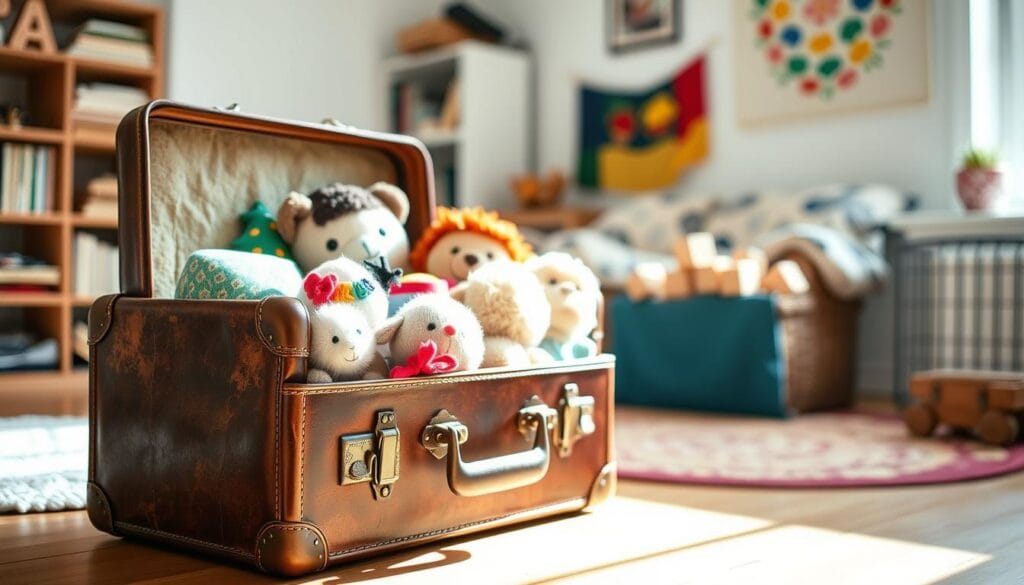
We often see children’s rooms get messy with toys all over. Upcycling old suitcases into storage is a smart fix. It’s more than tidying up—it’s about making something old new and exciting again.
Upcycled art projects inspire kids to be creative. Think about making playhouses or pirate ships from cardboard boxes. These can be simple or fancy, good for beginners or DIY experts. Doing these with your kids helps them be more creative and learn about reusing things.
Changing furniture for new uses is another great idea. Like turning an old dresser into a craft station. With some paint and new parts, it changes as your kid’s interests do. This makes it a useful piece for a long time.
- Crafting Toy Storage from Old Suitcases means less waste goes to landfills.
- Using upcycled furniture saves on resources and cuts down new making, helping the planet.
- These projects are also a way to save money while making the room look nice.
Adding these projects at home teaches kids about being eco-friendly. Schools sometimes do upcycling to show the good in recycling. Why not do it at home too? Create fishbowls from plastic bottles or make wall art from fabric scraps.
For extra ideas, look at these budget-friendly decor ideas for kids rooms. Be creative and make unique, eco-friendly, and budget-friendly spaces perfect for your kids!
| Upcycled Item | Purpose | Materials Needed | Benefits |
|---|---|---|---|
| Old Suitcases | Toy Storage | Paint, Stickers, Fabric | Reduces waste, charming decor |
| Cardboard Boxes | Playhouses | Paint, Tape, Markers | Enhances creative play, reusable |
| Old Dressers | Craft Stations | Paint, Drawers, Compartmental organizers | Adaptable for growing needs, sustainable |
| Plastic Bottles | Fishbowls | Scissors, Paint, Glitter | Educational, reduces plastic waste |
The Dining Room: Unique Upcycling Ideas
Imagine stepping into your dining room where the decor tells a story—a story of sustainability, creativity, and charm. By using vintage finds for a unique table set-up, you transform ordinary meals into extraordinary experiences. Let’s explore how to achieve this.
Upgrading dining chairs from old wood is good for the planet. It also adds a rustic feel to your space. Just sand down the wood, slap on some new paint, and reupholster the seats. Your dining area gets a fresh look and a personal touch.
Centerpieces from upcycled materials can wow on your table. Think of using old mason jars as vases with fresh flowers or branches. Or turn wine bottles into stylish candle holders. These centerpieces make your room a place of creativity.
Incorporate upcycling ideas in your dining room for a united look. Use old wooden crates to make a shelf for china or vintage cookbooks. Different crate sizes make this both useful and visually interesting.
Today, the ‘Green Revolution’ inspires us to repurpose and reuse. This means that using vintage finds for a unique table set-up is not just trendy. It also makes your dining space functional, stylish, and truly your own.
Finally, don’t forget the small details. Vintage fabrics make gorgeous table runners or napkins, bringing sophistication to your meals. These upcycling tips help you create more than a place to eat. You craft a space that tells a story of conscious, creative living.
Tips for Successful Upcycling Projects
Welcome to the last part of our upcycling guide! By now, you’re probably eager to start turning old items into something new and exciting. We’ll share key tips to make your upcycling projects shine. You’ll learn about choosing the right materials, must-have tools for beginners, and where to find creative inspiration.
First, picking the right materials is critical. Look for items at thrift stores, garage sales, or estate sales. Prices can be as low as $1 to $5. Upcycling can save you up to 90% on costs compared to buying upscale items new. Old picture frames, chairs, and glass jars can become unique and affordable decor.
Next, let’s talk about tools. Beginners should have basic items like sandpaper, hand tools, non-toxic paint, and brushes. A good glue gun or sewing kit is also useful for complex projects. These tools are key for transforming items beautifully.
Inspiration is crucial 🔑! Many get their project ideas from social media and blogs. You might find inspiration for a rustic headboard from an old door or planters from tin cans online. The online community is full of imaginative ideas. Plus, 67% of upcyclers feel happier with their home environment after a project.
Remember, upcycling is more than the final product. It brings joy, supports sustainability, and renews old items. 🌿 Upcycling saves money, reduces waste, and celebrates transformation. Happy crafting!

